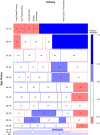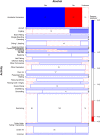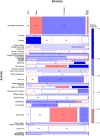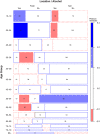Interacting Factors Associated with Adult Male Drowning in New Zealand
- PMID: 26083689
- PMCID: PMC4471112
- DOI: 10.1371/journal.pone.0130545
Interacting Factors Associated with Adult Male Drowning in New Zealand
Abstract
Objectives: i) to identify factors that contribute to the global trend of the higher incidence of male drowning relative to females, and; ii) to explore relationships between such factors from mortality data in New Zealand.
Methods: Drownings from 1983 to 2012 were examined for: Age, Ethnicity, Site, Activity, Buoyancy and Alcohol. Conditional frequency tables presented as mosaic plots were used to assess the interactions of these factors.
Results: Alcohol was involved in a high proportion of Accidental Immersion drownings (61%) and was highest for males aged 20-24 years. When alcohol was involved there were proportionally more incidences where a life jacket was Available But Not Worn and less incidences where a life jacket was Worn. Many 30-39 year old males drowned during underwater activities (e.g., snorkeling, diving). Older men (aged +55 years old) had a high incidence of drowning while boating. Different ethnicities were over-represented in different age groups (Asian men aged 25-29, and European men aged 65-74) and when involved in different activities.
Conclusions: Numerous interacting factors are responsible for male drownings. In New Zealand, drowning locations and activities differ by age and ethnicity which require targeted intervention strategies.
Conflict of interest statement
Figures





References
-
- Peden MM, McGee K (2003) The epidemiology of drowning worldwide. Injury control and safety promotion 10: 195–199. - PubMed
-
- Mackie I (1999) Patterns of drowning in Australia, 1992–1997. Medical Journal of Australia 171: 587–590. - PubMed
-
- Avery JG, Harper P, Ackroyd S (1990) Do we pay too dearly for our sport and leisure activities? An investigation into fatalities as a result of sporting and leisure activities in England and Wales, 1982–1988. Public Health 104: 417–423. - PubMed
-
- Nasrullah M, Muazzam S (2011) Drowning Mortality in the United States, 1999–2006. Journal of Community Health 36: 69–75. doi: 10.1007/s10900-010-9281-2 - DOI - PubMed
-
- Ahmed N, Andersson R (2002) Differences in cause-specific patterns of unintentional injury mortality among 15-44-year-olds in income-based country groups. Accident Analysis and Prevention 34: 541–551. - PubMed
Publication types
MeSH terms
LinkOut - more resources
Full Text Sources
Other Literature Sources
Medical

